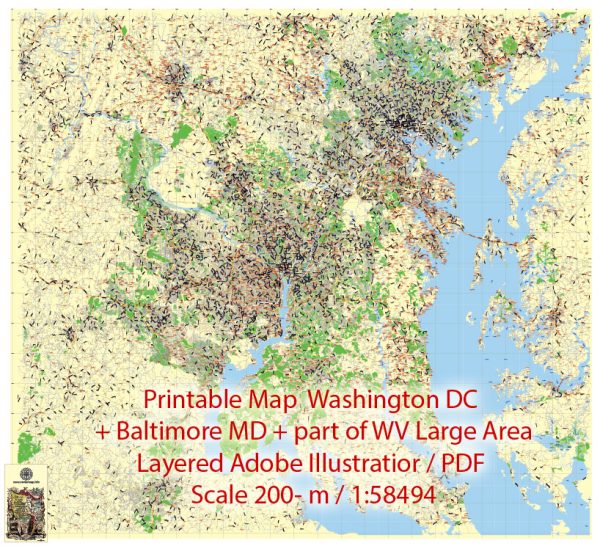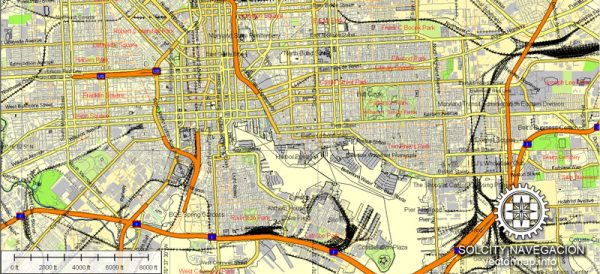Washington, D.C., and Baltimore, Maryland, are two neighboring cities with distinct histories of urban development. Here’s an overview of the key phases in the urban development of both Washington, D.C., and Baltimore:
Washington, D.C.:
- Planning and Establishment (1790):
- Washington, D.C., was established as the capital of the United States in 1790, following the Residence Act. Pierre Charles L’Enfant, a French-American architect, designed the city with a grand plan, featuring wide avenues and iconic landmarks.
- Federal Presence:
- The city was designed to be the political and administrative center of the new nation, with the Capitol, White House, and the National Mall serving as key symbols of the federal government.
- 19th Century Growth:
- During the 19th century, Washington, D.C., experienced steady growth, with the construction of government buildings, monuments, and residential areas. The city’s population increased as it became a hub for politics, administration, and culture.
- Civil War Impact (1861-1865):
- The Civil War had a significant impact on Washington, D.C., as it became a center for military operations and administration during the conflict.
- Urban Renewal and Development (20th Century):
- The 20th century saw urban renewal projects, including the development of the Federal Triangle, the construction of the National Archives, and the expansion of government facilities.
- Civil Rights Era:
- Washington, D.C., played a central role in the Civil Rights Movement, with historic events such as the March on Washington in 1963, where Martin Luther King Jr. delivered his famous “I Have a Dream” speech.
- Home Rule Act (1973):
- The Home Rule Act in 1973 granted Washington, D.C., greater autonomy in local governance, allowing residents to elect their own mayor and city council.
- Contemporary Development:
- Today, Washington, D.C., is a vibrant city with a mix of historic and modern architecture. It continues to evolve with ongoing development projects, cultural events, and a diverse population.
Baltimore, Maryland:
- Colonial Origins:
- Baltimore’s history dates back to the early 18th century when it was founded as a port town. Its location along the Chesapeake Bay contributed to its growth as a center for trade and commerce.
- Revolutionary War and War of 1812:
- Baltimore played a role in both the Revolutionary War and the War of 1812. During the latter conflict, Fort McHenry in Baltimore Harbor withstood a British naval bombardment, inspiring the writing of the “Star-Spangled Banner.”
- Industrialization and Transportation:
- The 19th century brought industrialization to Baltimore, with a focus on manufacturing, shipbuilding, and the development of the B&O Railroad. The city’s strategic location facilitated trade and transportation.
- Civil War and Post-War Growth:
- Baltimore was a key city during the Civil War, and its industrial base contributed to the Union war effort. After the war, the city continued to grow industrially and commercially.
- Great Fire of 1904:
- In 1904, a massive fire swept through Baltimore, destroying large parts of the city. The rebuilding efforts that followed led to modern infrastructure and architectural developments.
- Harbor and Port Development:
- The Inner Harbor became a focus of urban development in the mid-20th century, transforming into a major tourist destination with museums, restaurants, and attractions.
- Civil Rights Movement:
- Baltimore was also a significant location during the Civil Rights Movement, with events such as the desegregation of public facilities and protests against racial segregation.
- Deindustrialization and Urban Challenges:
- Like many American cities, Baltimore faced challenges in the latter half of the 20th century, including deindustrialization and urban decay. The city experienced population decline and economic struggles.
- Revitalization Efforts:
- In recent decades, Baltimore has focused on revitalization efforts, particularly in areas like the Inner Harbor and the redevelopment of abandoned industrial sites. Urban renewal projects aim to attract businesses and residents.
- Cultural and Educational Institutions:
- Baltimore is home to cultural and educational institutions such as Johns Hopkins University and the Baltimore Museum of Art, contributing to the city’s cultural vibrancy.
- Contemporary Challenges:
- Baltimore continues to grapple with challenges such as crime and socioeconomic disparities, even as efforts to revitalize and improve the city persist.
Both Washington, D.C., and Baltimore have played significant roles in American history, each contributing to the nation’s development in different ways. While Washington serves as the political and administrative heart of the country, Baltimore has been a key industrial and cultural center with a maritime heritage. Both cities continue to shape and redefine themselves in the 21st century.



 Author: Kirill Shrayber, Ph.D.
Author: Kirill Shrayber, Ph.D.